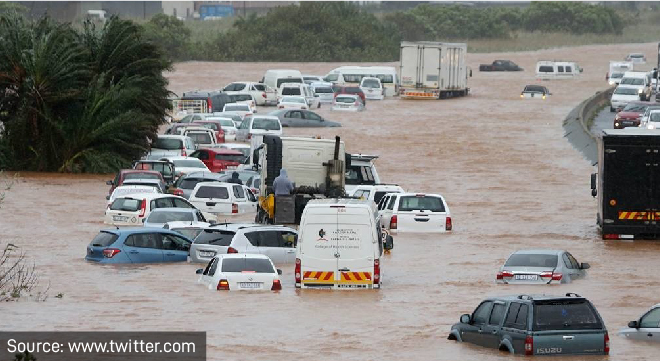The extensive flooding and landslides experienced on stretches of the KwaZulu-Natal coastline on 11 and 12 April should serve as a warning to the general population, and more pertinently, to South Africa’s non-life insurers and reinsurers that the country is no longer insulated from extreme weather catastrophes. In fact, all stakeholders in the insurance value chain should brace for an increase in the frequency and severity of natural catastrophe events that climate change experts have been warning of for decades.
The harsh reality is that the 2022 KZN floods, which claimed more than 450 lives and are estimated to have caused insured damage and losses to assets exceeding R15 billion, are more likely to repeat than not.
Recent reports by the country’s leading non-life insurers illustrate the scale of this event, with Santam admitting gross exposure totalling R3.2bn. The insurer commented that the flooding was a one-in-25-year loss event and the biggest natural catastrophe loss in its more than 100-year history.
Other insurers that commented on their exposures include Discovery Insure, with more than 1 800 claims and a total claims value north of R200 million; Old Mutual Insure, which expected a net impact of between R100m and R150m; Bryte Insurance, which had received about 500 personal lines and 900 commercial claims; and Hollard, with more than 3 000 claims notifications.
Global extreme weather
Fortunately, the price tag attached to local extreme weather events is unlikely to rival those seen in the Americas, Asia-Pacific and Europe.
The Swiss Re Institute has just confirmed about US$35bn in insured natural catastrophe losses for the first half of this year, a staggering 22% above the 10-year average. To put this in context, the KZN floods represent less than 3% of the global insured losses in the year to 30 June 2022, although this experience is well ahead of South Africa’s share of global non-life insurance premium, at about 0.6%.
Swiss Re singled out the widespread flooding in Australia earlier this year as a major contributor to the total, with its almost US$3.5bn claims experience among the costliest events on record over the period, and the biggest flood loss event in that country’s history.
The reinsurer noted that secondary perils, such as hailstorms and flooding, continue to drive insurance losses globally, exacerbated by rapid urban development and wealth accumulation in disaster-prone areas. This impact of urbanisation on insurers’ and reinsurers’ risk exposures is relevant given the likely changes in sea levels due to global warming, among other climate-related concerns.
Martin Bertogg, the head of catastrophe perils at Swiss Re, says: “The effects of climate change are evident in increasingly extreme weather events, such as the unprecedented floods in Australia and South Africa. This confirms the trend we have observed over the last five years, [being] that secondary perils are driving insured losses in every corner of the world. Insurers consider earthquakes, hurricanes and severe storms to be primary perils, whereas flooding and landslide would be considered secondary.”
Summer heatwaves in Europe
An assessment of insured natural catastrophe losses would be incomplete without comment on the extreme temperatures exhibited over much of Europe during June.
Swiss Re said that two severe summer heatwaves had contributed to record-high temperatures across Europe, sparking destructive forest fires across southwest Europe.
“As warming climate is predicted to exacerbate droughts, the likelihood of wildfires increases, causing greater damage where rapid urban sprawl overlaps the wildland-urban interface,” they said.
Gap in cover
One of the ongoing concerns raised by insurers and reinsurers is around the gap in insurance coverage for natural catastrophes.
Jérôme Jean Haegeli, Swiss Re’s group chief economist, says: “Climate change is one of the biggest risks our society and the global economy is facing. With 75% of all natural catastrophes still uninsured, we see large protection gaps globally exacerbated by today’s cost-of-living crisis.”
The reinsurer estimated total insured catastrophe losses, including man-made catastrophes, at US$38bn for H1 2022, compared to total economic losses of US$75bn.
About the author
Gareth Stokes is an author, content specialist and journalist who has recently published the third edition of his comprehensive guide to South Africa’s non-life (short-term) insurance sector. The book, titled “Everything you need to know about non-life insurance in South Africa” is available online at stokesmedia.co.za.



